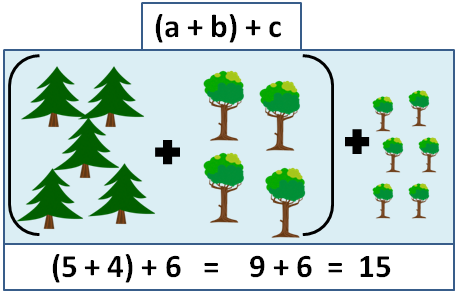Did you know that the associative property can help us solve problems faster? Today, we are going to learn about the associative property of addition, and the associative property of multiplication.
According to the associative property, we can regroup the numbers when we add, and we can regroup the numbers when we multiply.
The Associative Property of Addition
When we add three or more numbers, it does not matter how we group them, because the answer will be the same:
(a + b) + c = a + (b + c)
Let’s see an example:
In a park, there were 5 fir trees and 4 pines. The gardener has planted six more pines. How many trees are in the park now?
We can solve by grouping the addends in two ways, but we will always get the same answer (15). Let’s see it with images:
- First, we can add the trees that were there already in the park, (5 + 4) and then the pines that have just been planted (6). We are grouping the addends in this way:

- Now we will solve the problem by grouping the addends differently. First, add the pine trees (4 + 6). Then add the fir trees (5). We are grouping the addends in this way:

The Associative Property of Multiplication
When we multiply three or more numbers, it does not matter how we group them because the answer will be the same:
(a × b) × c = a × (b × c)
Let’s see an example:
To bring new basketballs to a sports center, two trucks have arrived with 10 boxes each. Inside each box, there are 8 basketballs. How many basketballs have reached the sports center?
We can answer it by grouping the factors in two ways, but still, end up with the same answer (160). Let’s see how this works:
- If we first multiply the number of trucks by the number of boxes in each truck (2 x 10), we get the total number of boxes (20). Then, we multiply by the number of basketballs in each box (20 x 8) and that gives us a total of 160 basketballs in all (see the diagram below):

- Now we will solve the problem by grouping the factors in a different way. This time, we will multiply the number of boxes by the number of basketballs in each box first (10 x 8), which gives us 80, the number of balls in each truck. Then, we multiply by the number of trucks (80 x 2) and we get 160 balls in total (see the diagram below):

In conclusion…
When you solve a problem where you have to multiply or add, remember that you can group your items in the way that works best for you!
What did you think of this post? Do you understand the associative property better now? If you have liked it, share it with your friends so that they can learn too.
And remember that on Smartick you will be able to find exercises to learn the properties of addition and multiplication and much more elementary math. Register now and try it for free!
Learn More:
- The Associative Property in Addition and Multiplication
- What is the Associative Property of Multiplication?
- Applying the Commutative Property of Addition and Multiplication in a Problem
- The Associative Property and Mental Math
- Properties of Multiplication








Nice work 👍
Well understood